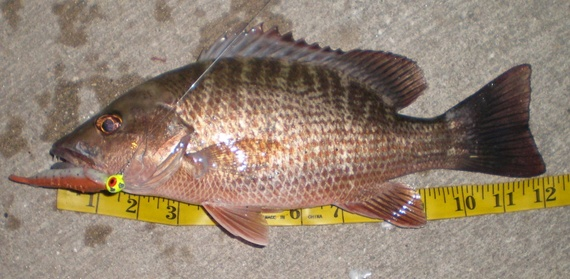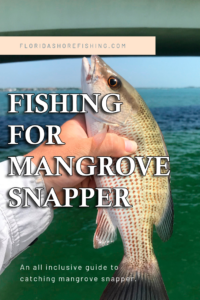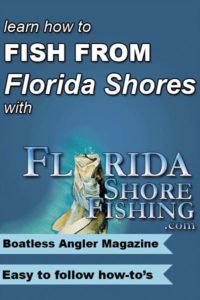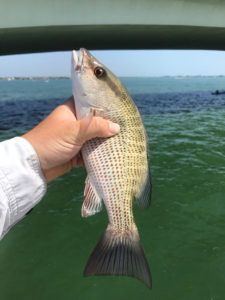
Mangrove Snapper Fishing
Mangrove Snapper (Lutjanus griseus), also known as the Grey Snapper is one of the most popular snapper species and is one of the few that can be caught consistently inshore. They are shaped like most other snappers, display coloring ranging from bronze to grey and have a mouth full of sharp teeth.
Mangrove Snapper spend the majority of their juvenile life inshore and move offshore when they reach maturity. Inshore they average between 10-14 inches and weight between 1-2 pounds. Offshore they can reach a size of over 20 pounds, but in shore, a fish over 3-4 pounds is very rare.
Where to Find Mangrove Snapper
Offshore they are primarily found around reefs and wrecks while inshore Mangrove Snapper can be found just about anywhere there is structure. They get their name from their preference to live around mangrove shorelines early on in life, but these are some other places that they are frequently found:
- Beach Piers
- Inlets
- Bridges and Docks
- Rock Piles / Oyster Beds
- Deep holes
Snapper species tend to be bottom dwelling fish and the Mangrove is no different, however, many times they will be found throughout the water column. It is rare to find them near the surface, but they are frequently found from mid depth down to the bottom.
Gear
Inshore, Mangrove Snapper rarely get above 2 pounds so just about any inshore, saltwater rated gear will work well. The most popular rod and reel combo when targeting these fish is a light spinning reel with a medium light action rod. Saltwater baitcasting reels are also very popular when fishing around structure with live bait.
Line
Because Mangrove Snapper are almost always found near heavy cover braided line is the best option. Braid has great abrasion resistance and is very strong. Line in the 10-20 pound test class will work well.
Mangrove Snapper have excellent eyesight so a tough, low visibility leader is a necessity. Fluorocarbon works perfectly for this task because of its abrasion resistance and is ultra low visibility in the water.. Use a leader that is between 12-20lbs.
Using Artificial Lures
Snapper have never been known as the most willing strikers of artificial lures but there are many that will work well. These are a few examples:
- Berkley Gulp Shrimp
- Curl Tail Grubs
- Soft Plastic Shrimp
- Soft Plastic Jerk Bait
- Mud Minnow / Finger Mullet imitation lures
When using artificial lures make sure to use a lure small enough to fit in the mouths of these fish. Cast as close to the structure as you can without getting snagged to frequently and work the bait slowly and erratically back. As with most snapper species, Mangrove snapper will hit hard, so set the hook as soon as a hit is detected.
Using Live Bait
Using Live bait is the most successful method of catching Mangrove Snapper. They are voracious predators and willing take many types of live bait. The stand alone best live bait for inshore snapper is Mud Minnows. Mud minnows last very long in captivity, are very durable on the hook and are almost irresistible to Mangrove Snapper. Other good baits include:
- Live Shrimp
- Small Finger Mullet
- Scaled Sardines
- Small Pinfish
- Small Crabs
Live Bait Rigs
For inshore snapper the two most popular rigs are the fish finder (aka carolina rig) and the knocker rig.
Fish Finder
The fish finder rig is a hook attached to a 12-20” leader. Above the leader is a barrel swivel, a bead and then a egg sinker. When using this rig, use only the amount of weight needed to hold the bottom and no more.
Knocker Rig
A knocker rig has a hook attached to a 12-20” leader that is directly attached to the main line. A egg sinker is threaded on to the main line and allowed to free float on the line all the way down to the eye of the hook. This allows the bait to be held directly on the bottom and with a small jig of the rod tip produce a small knocking sound when the sinker knocks into the eye of the hook.
Live Bait Techniques
After locating structure that is believed to hold fish, cast the bait a few yards up current of the structure.and remain just slightly up current. When relating to structure snapper become ambush predators and will sneak out of the cover and hit their prey.
When fishing from piers, docks, or bridges many anglers always assume that the deepest water will always be the most productive. This is almost always not the case! The most productive will be the areas with cover and current that will attract mangrove snapper. Study the structure. Look under the pier/dock/bridge for any areas that the current changes direction slightly, has a rock pile, a hole caused by current or any other structure. Drop the bait down just up current of this structure (most frequently either strait down or slightly under the structure you are fishing from).
Mangrove Snapper are most frequently aggressive strikers but at times can be subtle eaters as well. Most days they will hit a bait so hard it beds the rod immediately, but occasionally they will barely touch the bait and sit still while eating it. On days that the fish are hitting very lightly, reduce the size of your hook and the weight. This will not only make the hit easier to detect but will also encourage the fish to eat faster because of less resistance.
Many areas require circle hooks by law when fishing for reef fish (which all snapper are considered). When using these hooks be aware not to use the classic upward jerking motion to set the hook. These hooks were designed to grab the fish by the side of the mouth as it is being pulled out of their mouth, so all that is needed is a slight upward motion and to bein reeling in the line.
Tips and Tricks
- Mud Minnows are the BEST bait for inshore Mangrove Snapper
- Bridges and Piers that are near deep water often hold many fish
- Mangrove Snapper hold throughout the water column, not just the bottom
- Inshore fish prefer warmer water and tend to move offshore when the water cools
Related Links




Comment here
You must be logged in to post a comment.